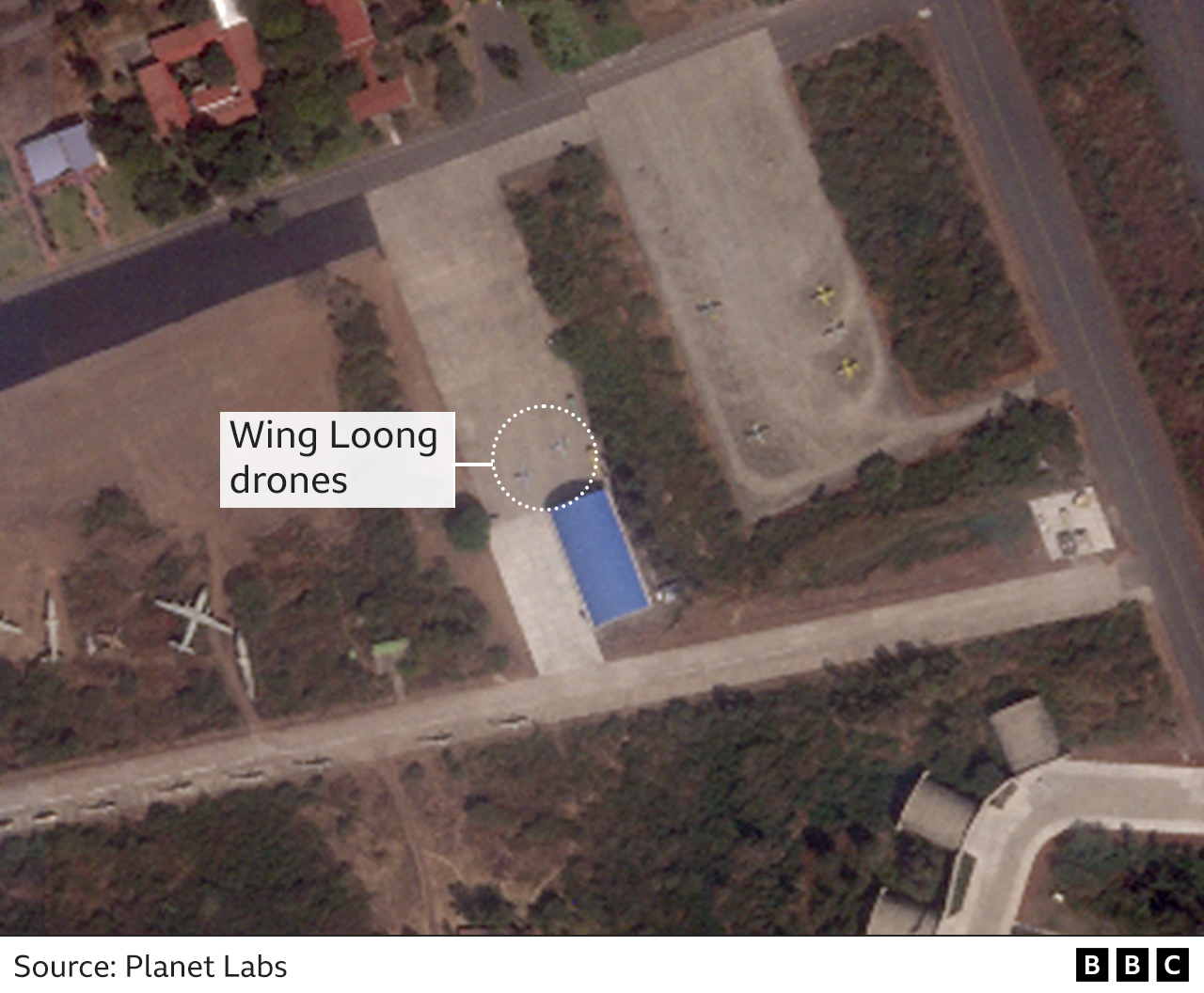Tigray conflict: What do we know about drone strikes in Ethiopia?
- Published

One of the casualties of the Dedebit attack being treated in hospital
Dozens of people have been killed in airstrikes in the northern Ethiopian region of Tigray in recent months.
Some of the attacks have involved the use of armed drones, and there's growing concern about the number of civilian casualties.
The government, which has been fighting rebels for over a year, says it has the right to use whatever arms it sees fit.
It denies that it has targeted civilians.
8 January: Attack on camp for displaced
An air attack on a camp for internally displaced people in Dedebit in Tigray on 8 January, killed more than 50 people and left more than a hundred injured.
Images of the aftermath - supplied to Politico, external by aid workers - have led open-source investigators to believe one weapon used in this incident could have been a missile fired from a Turkish-made Bayraktar TB2 drone.

Fragments - including wing pieces - appear to match those of a type fitted to these drones, according to researchers from the Netherlands-based Pax peace group and Amnesty International.
The presence of Turkish drones in Ethiopia was revealed in December by Wim Zwijnenburg, an investigator who works with Pax.
He highlighted satellite imagery showing Turkish drones parked at a government air base south of the Tigray region.
They can be identified by comparing the dimensions, including the wingspan and length, from satellite images.
Allow X content?
This article contains content provided by X. We ask for your permission before anything is loaded, as they may be using cookies and other technologies. You may want to read X’s cookie policy, external and privacy policy, external before accepting. To view this content choose ‘accept and continue’.

We don't know if these particular drones were used in this incident, and the Ethiopian government has not confirmed their use.
Turkey signed a defence co-operation agreement with Ethiopia last year, although the details were not made public.
Reuters reported in December that the US had voiced its concern to the Turkish government over drone sales to Ethiopia., external
6 January: Attack on Oromo rebels
An attack in early January was carried out on rebels in the Oromia region, who have made common cause with rebels in Tigray.
Few details have emerged, and it is not clear if there were casualties.
However, the air strike in the Gidami area did leave some evidence - missile fragments - which according to one investigation, suggested the use of Iranian munitions., external


Satellite imagery from last December revealed the presence of an Iranian drone at Harar Meda airport, identified by its dimensions and other features.
A flight-tracking investigator has identified about 15 cargo flights, external from Iran to Harar Meda and Bole airports in August 2021. What they were carrying is not known.
However, last October, the US authorities publicly condemned Iran for its drone exports and named Ethiopia as one of the recipients of Iranian drone technology., external
16 December: Alamata marketplace attack
In mid-December 2021, a series of air attacks led to the deaths of 28 civilians in a market place in Alamata in southern Tigray.
The main Tigray rebel group, the TPLF, alleged that government jets and drones were responsible., external

The remains of a tailpipe from a missile found after the attack in Alamata (shown on Tigrai TV)
Video footage was aired on a Tigrayan TV station, showing the remains of a missile said to have been used in this incident.
The missile motor tailpipe, which tends to survive impact, can be identified from the footage.
One open-source investigation - using publicly available information to try to establish exactly what happened - concluded that, based on these images, the fragments looked identical to a Chinese-made Blue Arrow 7 missile that can be mounted on a drone., external
Satellite imagery revealed that Chinese-manufactured Wing Loong drones were parked at Ethiopia's Harar Meda military airbase on 15 December - the day before the Alamata attack.
Open-source investigators believe China was the original source for Ethiopia's Wing Loong drones, initially intended for surveillance use.
Data from flight-tracking apps shows cargo shipments from Chengdu in China, home of state-owned drone manufacturer Chengdu Aircraft Industry, to Ethiopia in September and October last year.

Two Chinese-made Wing Loong drones seen on 15 December at the Harar Meda airbase

But there's another country with both Wing Loong drones and Blue Arrow missiles which has also sent supplies to Ethiopia - the United Arab Emirates (UAE).
Going by an arms database maintained by the Stockholm International Peace Research Institute (SIPRI), external, the UAE has both Wing Loong drones, and Blue Arrow missiles.

A Wing Loong II drone on display at an air show in China in 2021
And flight data research shows 119 cargo flights over a period of five months last year from UAE military airports to the Harar Meda air base (south-east of Addis Ababa) and Bole, the main international airport in the capital. Again, we can't be sure what these flights carried.
What does Ethiopia say?
Ethiopian government spokesperson Legesse Tulu would not go into details about the above incidents.
He told the BBC: "I will not say where, but the government has used them [drones] in different times and places." He also insisted they were not used against civilians.
We don't know for certain when these drones were supplied.
The BBC contacted the governments concerned about reports that armed drones from their countries have been used in Ethiopia - but they have not responded.
We also approached the Turkish defence company which makes the Bayraktar drone, but did not get a response.
There is no arms embargo on Ethiopia currently, and the export of armed drones is a grey area in terms of international regulation and treaties.
But their use in conflict zones around the world appears to be on the rise.
Wim Zwijnenburg, from the Pax group, believes the example of Ethiopia "raises serious questions, considering the many allegations of violations of international law".
